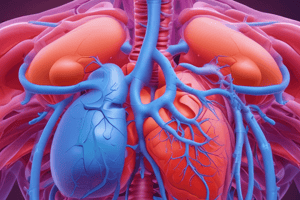Podcast
Questions and Answers
How can muscles be expanded and contracted during ventilation?
How can muscles be expanded and contracted during ventilation?
Piston movement of diaphragm and expansion/contraction of ribs
What are the three processes of respiration?
What are the three processes of respiration?
pulmonary ventilation, external respiration, internal respiration
Which muscles cause lung expansion during inspiration?
Which muscles cause lung expansion during inspiration?
Contraction of diaphragm and external intercostal muscles
What are the two types of breathing mentioned in the text?
What are the two types of breathing mentioned in the text?
What additional muscles are involved in heavy breathing?
What additional muscles are involved in heavy breathing?
What is the normal pleural pressure at the beginning of respiration?
What is the normal pleural pressure at the beginning of respiration?
During expiration, what happens to the lung's relation to the thoracic cavity?
During expiration, what happens to the lung's relation to the thoracic cavity?
What is the function of surfactant in relation to surface tension?
What is the function of surfactant in relation to surface tension?
What is the measure of forces of the lungs that tend to collapse the lungs?
What is the measure of forces of the lungs that tend to collapse the lungs?
How does the ANS regulate airway resistance during expiration?
How does the ANS regulate airway resistance during expiration?
Study Notes
Muscles and Ventilation
- Muscles can be expanded and contracted during ventilation through the contraction and relaxation of diaphragm and intercostal muscles.
Processes of Respiration
- The three processes of respiration are: inspiration, expiration, and relaxation.
Inspiration
- The diaphragm and external intercostal muscles cause lung expansion during inspiration.
Types of Breathing
- The two types of breathing mentioned are: quiet breathing and forced breathing.
Additional Muscles in Heavy Breathing
- Additional muscles involved in heavy breathing are: internal intercostal muscles, sternocleidomastoid muscles, and scalene muscles.
Pleural Pressure
- The normal pleural pressure at the beginning of respiration is -5 mmHg.
Expiration
- During expiration, the lung's relation to the thoracic cavity is that the lung volume decreases, and the lung moves upward into the thoracic cavity.
Surfactant
- The function of surfactant is to reduce surface tension in the alveoli, allowing for easier expansion of the lungs.
Lungs' Collapse
- The measure of forces of the lungs that tend to collapse the lungs is the elastic recoil of the lungs.
ANS Regulation
- The ANS regulates airway resistance during expiration by stimulating the vagus nerve, which causes the airway to constrict and increase resistance.
Studying That Suits You
Use AI to generate personalized quizzes and flashcards to suit your learning preferences.
Description
This quiz covers the process of respiration including pulmonary ventilation, external and internal respiration, and regulation of ventilation. It also includes the mechanics of ventilation, focusing on the expansion and contraction of muscles such as the diaphragm and ribs to facilitate breathing.




